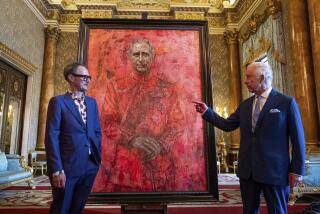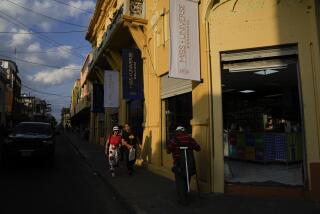CULTURE : Lewd Painting of Revolutionary Draws Outrage in S. America : Some intellectuals warn that the flap over the portrait of independence leader Simon Bolivar may fuel censorship.
- Share via
SANTIAGO, Chile — Simon Bolivar, the great general who led the South American war of independence from Spain, is portrayed by a Chilean painter as an enigmatic figure with feminine breasts, lace stockings and no pants. This “Liberator” sits on a stylized steed, making a lewd gesture with his extended middle finger.
The painting by Juan Davila has provoked public outrage in several South American countries, protests from offended governments, an official apology from Chile and a lively public debate over freedom of artistic expression. Some intellectuals warn that the flap may fuel the fires of censorship.
Bolivar was commander in chief of the patriotic forces that freed Venezuela, Colombia, Ecuador, Peru and Bolivia from Spanish rule in the early 1800s. His memory is revered throughout Latin America, and portraits of him have generally depicted a dignified, manly hero.
But Davila’s recent rendition shows a fellow of ambiguous sex, wearing a black lace stocking below a naked, fulsome hip.
It might not have caused such an uproar had it not been reproduced on 500 postcards that circulated in Chile and abroad in an art-promotion project financed by Chile’s Fondart, a government fund under the Education Ministry. The works of three other Chilean artists were reproduced on cards that went out in the same “postal exhibition.”
Fondart officials have said the project grant was awarded without censorship of the pictures. Critics argue that public funds should not have been used to promote so offensive a picture.
Davila, who lives in Australia, has not surfaced since the controversy exploded more than a week ago. But Chilean critics and artists who know his work say the Bolivar painting uses symbolism to criticize the predominance of patriarchal figures in standard versions of Latin American history.
“No one can doubt that, from the first school books, history is written in the masculine,” wrote Chilean art critic Justo Pastor Mellado. “Where the hero should show his hairy chest, Davila reproduces the cleavage of feminine breasts. . . . What should be seen, behind that opening, is the presence of the hidden women of our independence.”
The strongest reactions to the painting came from Caracas, Venezuela, where Bolivar was born. Venezuela sent a formal protest to the Chilean government over what the Venezuelan Embassy here called a “campaign that is being orchestrated against the prestige of the most sacred figure of our nationality.”
Colombia and Ecuador also made formal protests to Chile. “This painting is a blasphemy from the historical point of view, pornographic as art and incomprehensibly defamatory,” the Colombian ambassador said.
After a week of controversy, the Chilean Foreign Ministry issued an apologetic statement Tuesday acknowledging that the “clearly disrespectful content” of the painting “deeply wounds the sensibilities of all who value the contribution of the remarkable Venezuelan to the freedom of Latin America.” The ministry presented Chile’s excuses to Venezuela, Colombia and Ecuador for “this lamentable incident,” the statement said.
The same day, a group of protesters in Caracas burned a Chilean flag outside Chile’s embassy. The demonstrators demanded that Davila’s painting be brought to Venezuela to be burned.
No one in Chile openly advocates suppression of artworks by public burning, but defenders of artistic freedom worry about more subtle forms of censorship, especially by institutions that finance the arts. In fact, the chairman of the Chilean Senate has recommended that Fondart funds go only to institutions and not directly to artists. Writer Raquel Olea said in a newspaper column Friday that such proposals “put Chilean intellectuals and artists on alert.”
More to Read
Sign up for Essential California
The most important California stories and recommendations in your inbox every morning.
You may occasionally receive promotional content from the Los Angeles Times.













